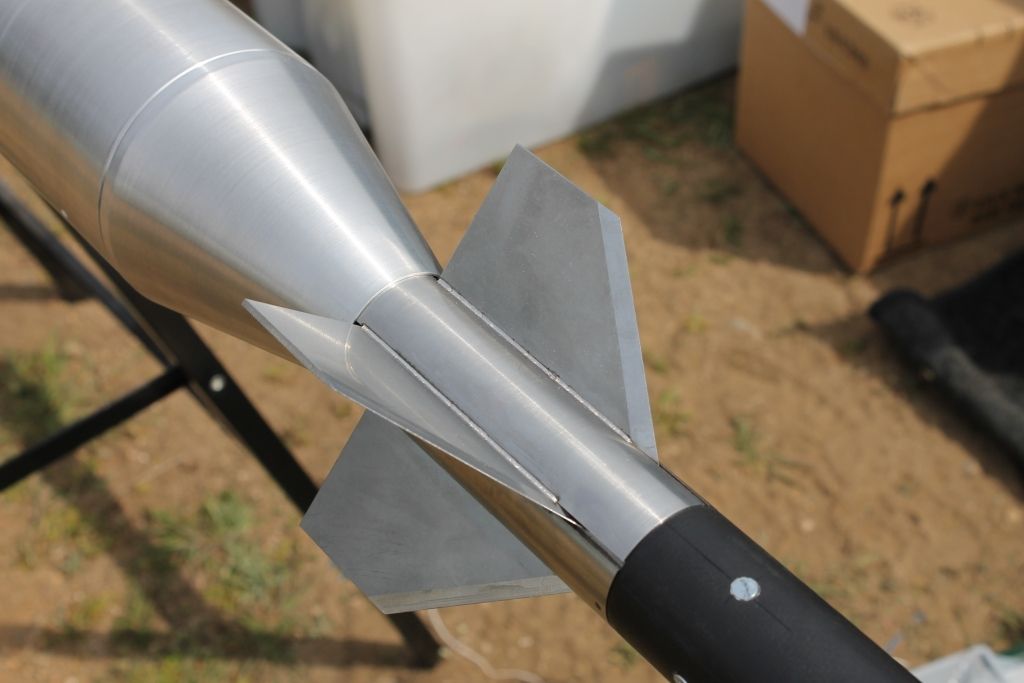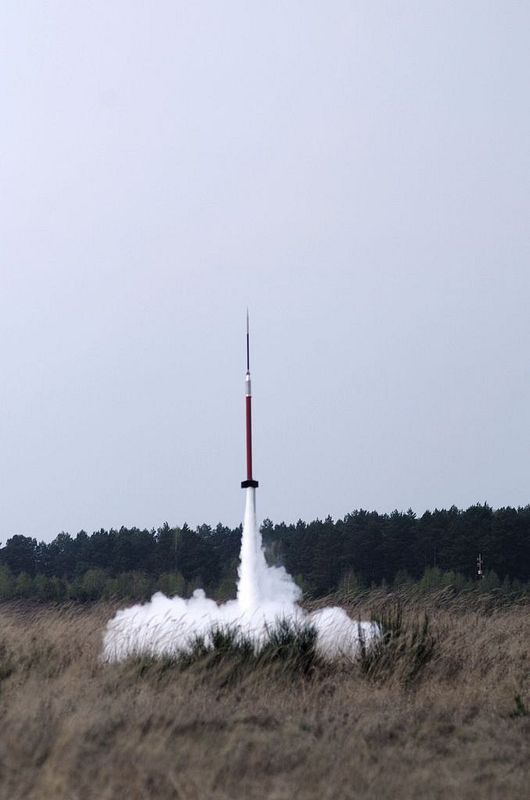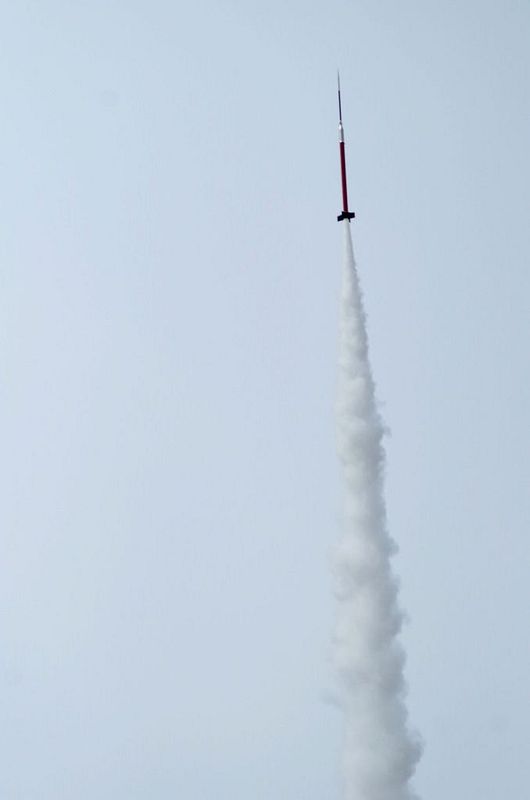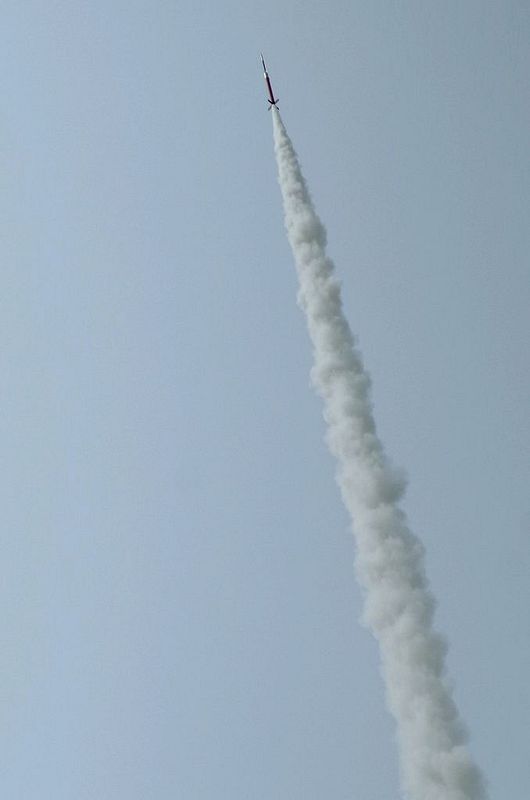You are using an out of date browser. It may not display this or other websites correctly.
You should upgrade or use an alternative browser.
You should upgrade or use an alternative browser.
100,000' on M Power. Can it be done?
- Thread starter EeebeeE
- Start date

Help Support The Rocketry Forum:
This site may earn a commission from merchant affiliate
links, including eBay, Amazon, and others.
bobkrech
Well-Known Member
- Joined
- Jan 20, 2009
- Messages
- 8,352
- Reaction score
- 55
Again, please take a look at the original Loki-Dart PWN-1A specifications. It was a 3" OD booster rated at 17100N9000 weighing 29 pounds with a 1.375" OD dart weighing 7 pounds and a sectional density of 4.7 pounds per square inch. It reached a peak velocity of 3900 mph and had an apogee of 46 miles (243,000').That will slow the whole thing down. Of course with the dart, momentum is more important that velocity, So I could see how it works ... That is if I can get OR to work.
The largest CTI 75 mm motor is the Pro75 6GXL 9977M2245-P with a burn time of 4.3 seconds. The Pro75 6G 6800M3700-P has a 1.8 second burn time more appropriate to the Loki motor. Neither comes close in total impulse nor with the high average thrust of the Loki, Your rocket does not have the total impulse, maximum velocity, or the sectional density to get close to 100,000'. With 1/3 the total impulse of the Loki prototype, your potential apogee is reduced by a factor of 3, and with a sectional density that is less than 40% of the original dart, you loose another apogee factor of 2.5. As previously stated, I don't think you can get more than 40,000' AGL at Black Rock with your boosted dart configuration.
BTW - There appears to be a stability issue with the powered sustainer stage version at high velocity. My guess is the fins are a bit too small so when the CP moves forward and the CG move back in the burn, the rocket appears to go unstable and that's why the minimum staging delay has to be ~5.75 seconds.
Bob
EeebeeE
Well-Known Member
- Joined
- Aug 7, 2011
- Messages
- 1,427
- Reaction score
- 56
I agree a boosted dart will not achieve 100K powered by an M. The sims favor a motor with more overall power and a longer burn than a short burn motor with high avg. NS, however. Slower launch velocity but the longer burn time of an M2020 will deliver a higher velocity than a short burn M3700, which has about 2,000 fewer NS.
In this boosted dart design 5 lbs. of weight in the nose was the optimal and OR dimmed the flight to 60K. Probably would net down to 50K because OR tends to be a little ambitious. Might try a 29mm dart instead of 3838mm to see if it makes a difference.
John, do you think I could get away with flying a much smaller boosted dart at Geneseo if I could keep it under waiver? I'd like to experiment with one.
In this boosted dart design 5 lbs. of weight in the nose was the optimal and OR dimmed the flight to 60K. Probably would net down to 50K because OR tends to be a little ambitious. Might try a 29mm dart instead of 3838mm to see if it makes a difference.
John, do you think I could get away with flying a much smaller boosted dart at Geneseo if I could keep it under waiver? I'd like to experiment with one.
- Joined
- Jan 23, 2009
- Messages
- 5,991
- Reaction score
- 4,099
John, do you think I could get away with flying a much smaller boosted dart at Geneseo if I could keep it under waiver? I'd like to experiment with one.
I do not see why note. Its not a staged flight, it's just a rocket which recovers in two pieces.
BayouRat
Well-Known Member
I don't think it's physically possible.
- Joined
- Apr 13, 2013
- Messages
- 2,444
- Reaction score
- 1,363
Sure it can be done, you just need to get out of the heavy atmosphere. How about launching from the Moon's surface?
EeebeeE
Well-Known Member
- Joined
- Aug 7, 2011
- Messages
- 1,427
- Reaction score
- 56
Riley,
I came up with a design that uses a 38mm motor to send a dart up to 9,000'. Much less expensive. This I could build it out of Blue Tube. I have some leftover G10 FG for the fins. Just need a couple other parts. Thinking that the dart needs to be rear deploy because of the weight that has to go into the nose.
I came up with a design that uses a 38mm motor to send a dart up to 9,000'. Much less expensive. This I could build it out of Blue Tube. I have some leftover G10 FG for the fins. Just need a couple other parts. Thinking that the dart needs to be rear deploy because of the weight that has to go into the nose.
Would this work?
I replaced the motor in the booster with a M2245 and the sustainer motor with a L265. In this configuration, it goes to 141,000 ft.
View attachment 272124
I replaced the motor in the booster with a M2245 and the sustainer motor with a L265. In this configuration, it goes to 141,000 ft.
View attachment 272124
dave carver
....what hump?
Sure it can be done, you just need to get out of the heavy atmosphere. How about launching from the Moon's surface?
Second best would be Hartsel, Colorado and it's 8800 foot elevation
A research launch would be best. I would optimize the nozzles to have the correct expansion at mid-point of the expected altitudes that the motors would be burning. The expansion of the stock nozzles are a joke at best, they are all some weird ass compromise. It would be very worth the effort, we're talking big changes in performance.
EeebeeE
Well-Known Member
- Joined
- Aug 7, 2011
- Messages
- 1,427
- Reaction score
- 56
Would this work?
I replaced the motor in the booster with a M2245 and the sustainer motor with a L265. In this configuration, it goes to 141,000 ft.
View attachment 272124
Your solution is 12,624 NS. That is N power. Need to keep it below 10,240 NS. The real challenge is to keep it below 10,000 NS.
Just for reference here is a boosted dart project that I flew in April 2015. Booster is a sugar motor with a 10.700Ns total impulse. Dart weighed 8,8lbs and had a 37mm OD. Dart boat tail, nosecone, fins and portion of body tube were made from solid stainless steel. It made it to +35.000ft. There is however a lot of room left for improvement. The booster could be made at least 3-4 pounds lighter, and the dart could be made much smaller. The problem is stuffing so much mass in such a small diameter dart. I've made sims that show that 60.000ft is possible with a lightened booster and a 20mm OD tungsten dart, and that's with a sugar motor. With an AP motor 100.000ft should be within reach for a well designed EX M motor boosted dart. I'm not sure if it can be done with a commercial motor.
[video=youtube;9vcAQPJUqV0]https://www.youtube.com/watch?v=9vcAQPJUqV0[/video]
[video=youtube;9vcAQPJUqV0]https://www.youtube.com/watch?v=9vcAQPJUqV0[/video]
Xrain
Well-Known Member
- Joined
- Nov 26, 2013
- Messages
- 282
- Reaction score
- 30
A 20mm tungsten carbide dart... That is identical to a APFSDS armor piercing tank round; from speed and diameter to even material makeup.
Might I suggest not building something capable of going through over half a meter of armor plate, or destroying a main battle tank...
Might I suggest not building something capable of going through over half a meter of armor plate, or destroying a main battle tank...
A 20mm tungsten carbide dart... That is identical to a APFSDS armor piercing tank round; from speed and diameter to even material makeup.
Might I suggest not building something capable of going through over half a meter of armor plate, or destroying a main battle tank...
Why not :y:. Seriously, I don't know where are you pulling this from. We've come from optimizing boosted darts for achieving higher altitudes to destroying main battle tanks. Tungsten would be used because of its high density. You can't get so much mass in such a small diameter dart with steel or lead. Of course if you wan't to make a deep hole in the sky or a deep hole in a tank armor you use the same method, but that doesn't mean that such an amateur boosted dart can easily be made into an effective anti-tank weapon system. First you have to HIT the target and that is a big accomplishment. It's the same as if you would try to shoot down an airliner flying at 30.000ft with an average high power rocket. You can launch as many rockets as you wan't, but you have only about 1 in 100.000.000 chance of actually knocking it down. Why do you think that billions of dollars and thousands of very smart people are working on weapon systems development if it's so easy to hit something.
Last edited by a moderator:
grouch
Well-Known Member
IIRC, tungsten is not allowed for hobby use.
That's a function of locale.
Xrain
Well-Known Member
- Joined
- Nov 26, 2013
- Messages
- 282
- Reaction score
- 30
Why not :y:. Seriously, I don't know where are you pulling this from. We've come from optimizing boosted darts for achieving higher altitudes to destroying main battle tanks. Tungsten would be used because of its high density. You can't get so much mass in such a small diameter dart with steel or lead. Of course if you wan't to make a deep hole in the sky or a deep hole in a tank armor you use the same method, but that doesn't mean that such an amateur boosted dart can easily be made into an effective anti-tank weapon system. First you have to HIT the target and that is a big accomplishment. It's the same as if you would try to shoot down an airliner flying at 30.000ft with an average high power rocket. You can launch as many rockets as you wan't, but you have only about 1 in 100.000.000 chance of actually knocking it down. Why do you think that billions of dollars and thousands of very smart people are working on weapon systems development if it's so easy to hit something. Anyway, get real and stop talking out of your a**.
Sorry Andrej, I didn't properly convey what my implications were. I wasn't implying you are attempting to make an anti-tank weapon or that your rockets can even reasonably be used as one. You are definitely right that it would make a terrible weapon.
What I was trying to point out is that you are kinda entering a completely different realm compared to a normal boosted dart, or a normal rocket. I am guessing the separation speed for your dart was ~mach 3 - 4. With that extraordinarily high cross sectional density you get with the tungsten it has a ton of inertia for how much drag it has. Which is why you get the great altitude results. At the same time it is even more resistant to slowing down coming back down specially with gravity now on it's side.
So if you get some weather cocking, a damaged fin on ascent, a kink in the motor tube, or you get an off nominal trajectory; it's very possible to get an apogee at much lower altitude, and much higher speeds than you are expecting. If you hit apogee at mach 1-2+ your recovery device is probably going to disappear right on deployment. The dart might not lose very much speed depending on how that went. The dart actually has a pretty solid chance of accelerating on decent even at high mach since it's drag is so low. With a bad trajectory you could easily get 10,20,30 km away from your launch point.
This means your dart hitting the ground at mach 2 is very possible, even from a nominal attitude with just a recovery failure. It's also possible for it to hit the ground doing mach 3-4 if the conditions are right. A .50 cal bullet can pretty easily go through 6-12in of reinforced concrete. Your dart has ~40 times the cross sectional density compared to a .50 cal bullet (assuming 8 lbs for dart) as well as 50 times the kinetic energy (at mach 2) that goes up to 185 times the kinetic energy at mach 4. It also likely wouldn't even have melting problems even at hypersonic speeds; so not much hope of it melting enough to destabilize itself.
This is why I said something. It is really easy to start pushing boundaries like this, without thinking of all the ramifications of what that causes. If you even just have a recovery system failure on a completely nominal flight to 100,000 feet. It is going to come down faster than most bullets, with a sizable percentage of the energy and penetrating power of a round fired by an Abrams tank. There are very few man made structures or objects that I can think of that it would not go through. If it hit a house it would go clear through the house and end up 30 feet under the concrete foundation. Heck it would probably make it into the basement coming in from the top of a 30 story building.
That does not mean it is impossible to fly. It just means that your safety analysis you do for a flight like this probably needs to be quite a bit more significant than what you have done for your previous flights, as well as possibly considering ways to ensure it isn't stable on the way down even in the event of failures, and other such measures. Cause despite the pretty low odds of it hitting something coming back down, it doesn't take much to be unlucky. Maybe even going as far to launch from an actual sounding rocket range.
Just some food for thought.
Last edited:
bobkrech
Well-Known Member
- Joined
- Jan 20, 2009
- Messages
- 8,352
- Reaction score
- 55
Please watch your language. Keep it on topic.
The original mission of the Loki Dart was as a post WW2 anti-aircraft missile to counter high flying Soviet bombers that flew above the range of AA guns. The high sectional density, high ballistic coefficient dart achieved much altitude than AA guns or standard AA missiles of similar weight. They were made in mass quantities but as they were unguided, and couldn't hit the broadside of a barn let alone a high flying bomber and were taken out of inventory quickly.
https://www.designation-systems.net/dusrm/app4/loki.html
While absolute useless as a weapon, the mil-surplus boosters were used as no-cost boosters for carrying scientific payload into the upper atmosphere....and this is how sounding rockets are developed.
https://www.designation-systems.net/dusrm/n-1.html
And to definitively answer the OPs question can an M impulse motor launch a payload to 100 kft.....
Yes. The Navy's HASP rocket was propelled by a 5% N (10.8 KNs) and apogee at 22 miles. Reduce the propellant to 10.24 KNs and you would get 20 miles which is >100 kft.
https://www.designation-systems.net/dusrm/app4/hasp.html
Bob
The original mission of the Loki Dart was as a post WW2 anti-aircraft missile to counter high flying Soviet bombers that flew above the range of AA guns. The high sectional density, high ballistic coefficient dart achieved much altitude than AA guns or standard AA missiles of similar weight. They were made in mass quantities but as they were unguided, and couldn't hit the broadside of a barn let alone a high flying bomber and were taken out of inventory quickly.
https://www.designation-systems.net/dusrm/app4/loki.html
While absolute useless as a weapon, the mil-surplus boosters were used as no-cost boosters for carrying scientific payload into the upper atmosphere....and this is how sounding rockets are developed.
https://www.designation-systems.net/dusrm/n-1.html
And to definitively answer the OPs question can an M impulse motor launch a payload to 100 kft.....
Yes. The Navy's HASP rocket was propelled by a 5% N (10.8 KNs) and apogee at 22 miles. Reduce the propellant to 10.24 KNs and you would get 20 miles which is >100 kft.
https://www.designation-systems.net/dusrm/app4/hasp.html
Bob
That was uncalled for. And he has a point anyway. IIRC, tungsten is not allowed for hobby use.
Plus he said 'capable'. Which it has the ability to. Not that it will.
Pretty sure it's perfectly fine in the forests of Slovenia.
Andrej - thanks as always for the innovation and fresh perspective. My most recent project (targeting 75,000') is my own feeble attempt at tossing all accepted hobby concepts and norms out the window, and purpose-building an efficiency solution from the ground up. Flying it next week, we'll see how it goes.
Hopefully you're able to come to Black Rock some day soon with a project and share your ideas with some of us stateside. I assume the 60,000' boosted dart is the next project? When do you plan on flying it?
Regards,
Steve
grouch
Well-Known Member
Andrej, your boosted dart is a phenomenal piece of kit. I wished you had a build thread on it with more pictures. It would be impressive to see what you could do with more powerful motors.
EeebeeE
Well-Known Member
- Joined
- Aug 7, 2011
- Messages
- 1,427
- Reaction score
- 56
With my limited understanding of boosted darts I was able to sim to 75K. That was with a 3" min dia booster and a 38mm dart. The dart weighed approx 6 lbs and was fg with about 5 lbs of nose weight. Once I started going above that, altitude started to diminish. How could I improve the design?
bobkrech
Well-Known Member
- Joined
- Jan 20, 2009
- Messages
- 8,352
- Reaction score
- 55
Sim this rocket (the dart weighs 7 pounds). https://www.designation-systems.net/dusrm/app4/hasp.html You should get an apogee of 35 km or 22 miles and a peak velocity of 4800 km/s or 3000 mph @ 0.8 seconds. If not, your sim is not valid for these velocities. Darts typically need a spin rate o 20-25 Hz or they will not go straight.With my limited understanding of boosted darts I was able to sim to 75K. That was with a 3" min dia booster and a 38mm dart. The dart weighed approx 6 lbs and was fg with about 5 lbs of nose weight. Once I started going above that, altitude started to diminish. How could I improve the design?
Bob
Xrain, I apologize for my outburst. I have a sore spot for these kind of statements. Even in everyday life when I tell people that I build rockets they look at me like I'm some kind of a nut or a terorist. I agree that carefull planing is very important. Luckily from last year I have a chance to fly from one of the largest artillery ranges in Europe. I guess that if it's OK for 155mm HE howitzer rounds it should be OK for a small boosted dart.
Prophecy, Black Rock seems like a rocketeers dream, but for me to fly there would be an almost impossible financial problem. My next project is a boosted dart as well, but this time with a slightly larger motor (110mm, 35kNs). The dart will be larger as well (50mm OD) and will also have an on-board camera. It should go to about 45-50kft. This flight will be not so much for maximum altitude, but to flight test the booster motor. Flight is planned for October 17th if the weather cooperates. This motor design will be then used as a booster stage of a future two stage rocket, that I'm planing to launch in April 2016. I am following your thread on 75kft project. I'm keeping my fingers crossed and I hope that everything works as planned.
Grouch, thanks for the nice words. I wish that I would make more build photos, but as I'm always running out of time, that's usually the last thing that comes to my mind. Here is an upclose of the booster-dart interstage and dart fins. Fins are made from stainless steel and are laser welded to the body.

Here is some more launch photos made by Andrzej Chwastek from Polish rocket society:




Prophecy, Black Rock seems like a rocketeers dream, but for me to fly there would be an almost impossible financial problem. My next project is a boosted dart as well, but this time with a slightly larger motor (110mm, 35kNs). The dart will be larger as well (50mm OD) and will also have an on-board camera. It should go to about 45-50kft. This flight will be not so much for maximum altitude, but to flight test the booster motor. Flight is planned for October 17th if the weather cooperates. This motor design will be then used as a booster stage of a future two stage rocket, that I'm planing to launch in April 2016. I am following your thread on 75kft project. I'm keeping my fingers crossed and I hope that everything works as planned.
Grouch, thanks for the nice words. I wish that I would make more build photos, but as I'm always running out of time, that's usually the last thing that comes to my mind. Here is an upclose of the booster-dart interstage and dart fins. Fins are made from stainless steel and are laser welded to the body.

Here is some more launch photos made by Andrzej Chwastek from Polish rocket society:




Last edited:
grouch
Well-Known Member
Unfreaking real! Thanks for the pics. Just curious as to why you chose the booster fin shape you did as opposed to a clipped delta. Was it to get the maximum area as far aft as possible? Also, does the booster just free fall or is there a chute associated? I seriously wished you could get this rocket to the U.S. So you could fly it on a large AP motor.
Fin shape was chosen based on the required fin area and the fact that the fin root chord was set by the nozzle lenght. Fin can slips over nozzle divergent portion and is threaded to the edge of the motor casing. Booster has an altimeter and a RDF tracker and is recovered with a small chute.
Here is an upclose photo of the motor and the fin can:


Here is an upclose photo of the motor and the fin can:


MClark
Well-Known Member
Beautifully done.
Different locales allow different materials and techniques. This design is good where Andrej is launching.
If it was brought to Black Rock the steel would have to be replaced and the descent rate of the dart slowed down. But he does not launch at BR.
Keep sending reports,
Mark
Different locales allow different materials and techniques. This design is good where Andrej is launching.
If it was brought to Black Rock the steel would have to be replaced and the descent rate of the dart slowed down. But he does not launch at BR.
Keep sending reports,
Mark
grouch
Well-Known Member
Andrej, you are my hero. In my eyes this damn near borders professional rocketry. It is several farts beyond bad ass.
Xrain
Well-Known Member
- Joined
- Nov 26, 2013
- Messages
- 282
- Reaction score
- 30
Those rockets look fantastic Andrej! That is some pretty fantastic machining/welding!
An artillery range definitely makes for a great spot to do the more interesting kinds of rocketry!
We have a pretty good sounding rocket range up here as well, I think it has the largest land area to land rockets than any other range in the US. Even though its owned by my university it is a pretty big pain to launch from there since it is a "NASA range". Meaning I have to do some kinda silly things like fly a NASA certified pyro technician up from wallops to supervise assembling a COTS aerotech motor.
An artillery range definitely makes for a great spot to do the more interesting kinds of rocketry!
We have a pretty good sounding rocket range up here as well, I think it has the largest land area to land rockets than any other range in the US. Even though its owned by my university it is a pretty big pain to launch from there since it is a "NASA range". Meaning I have to do some kinda silly things like fly a NASA certified pyro technician up from wallops to supervise assembling a COTS aerotech motor.
rocketsaway
Well-Known Member
Fins are made from stainless steel and are laser welded to the body.
Whoa. you went all out on this project, but... why the rail ?
Thanks for the nice words, I'm trying to do my best.
I used the rail becuse it's easier to transport and quicker to set up. There is an additional drag penalty from the launch lugs, but that is negligible since the booster drops out at about 3000feet and the dart coasts for more than 30.000feet without any launch lugs to slow it down. When I flew this same motor in a single stage version I used a launch tower. Here is the video:
[video=youtube;z4QmCuDgi_w]https://www.youtube.com/watch?v=z4QmCuDgi_w[/video]
I used the rail becuse it's easier to transport and quicker to set up. There is an additional drag penalty from the launch lugs, but that is negligible since the booster drops out at about 3000feet and the dart coasts for more than 30.000feet without any launch lugs to slow it down. When I flew this same motor in a single stage version I used a launch tower. Here is the video:
[video=youtube;z4QmCuDgi_w]https://www.youtube.com/watch?v=z4QmCuDgi_w[/video]
Similar threads
- Replies
- 7
- Views
- 295
- Replies
- 10
- Views
- 1K
- Replies
- 59
- Views
- 2K
- Replies
- 16
- Views
- 627
- Replies
- 80
- Views
- 5K


